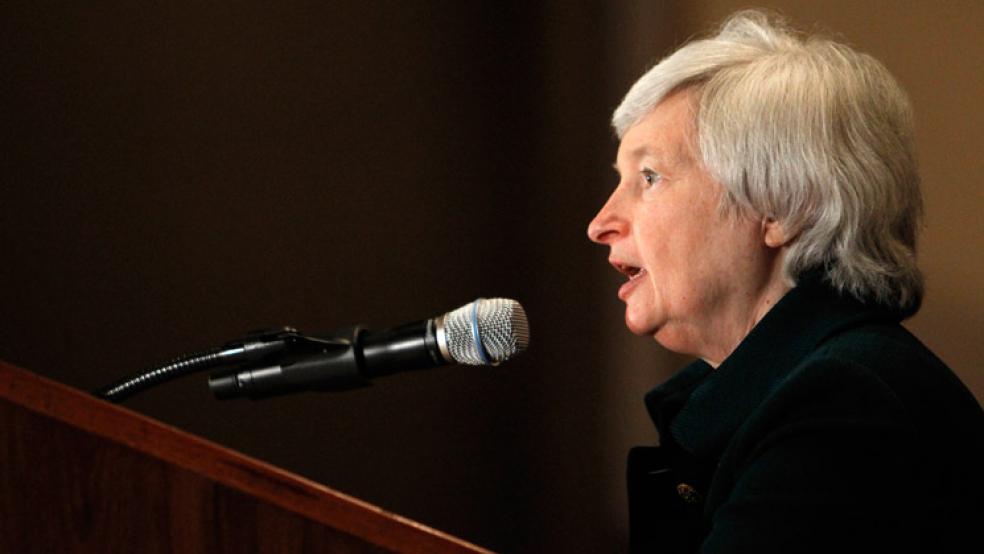For Federal Reserve Board Chair Janet Yellen, explaining monetary policy to the public is something of a bank shot. She wants to provide the markets with a level of certainty about the Fed’s intentions without committing herself and other Fed policymakers to any particular action at any particular time.
Think of it as trying to be as clear as she possibly can about the Fed’s ends -- while keeping all of the central bank’s options open when it comes to the means it will use to achieve them.
Related: Here’s What Janet Yellen Really Said About Rate Hikes
On Wednesday, at the Economic Club of New York, Yellen delivered a speech with the same general tenor of cautious optimism that she expressed in her first post-FOMC press conference last month. The economy has come a long way from the depths of the recession, she said, but it has done so painfully slowly, in the face of a jobs market she described as “perplexing” in its balky journey back toward full employment.
“It is a sign of how far the economy has come that a return to full employment is, for the first time since the crisis, in the medium-term outlooks of many forecasters,” said Yellen, who took over as Fed chair in February. “It is a reminder of how far we have to go, however, that this long-awaited outcome is projected to be more than two years away.”
The speech was delivered on the same day that the Federal Reserve board released its “Summary of Commentary on Current Economic Conditions,” commonly known as the Beige Book. The report found that “modest” or “moderate” economic growth was occurring in the majority of the 12 Federal Reserve Districts.
The overall aim of the speech appeared to be to cement the notion, which both she and her predecessor Ben Bernanke have stressed, that the Federal Open Market Committee makes its decisions about monetary policy based on what it sees in the data, rather than trying to toe the line of previous predictions or market expectations.
Related: When Yellen Meets the Press, Markets Could Tremble
“If the economy obediently followed our forecasts, the job of central bankers would be a lot easier and their speeches would be a lot shorter,” Yellen said. “Alas, the economy is often not so compliant.”
She said, “While monetary policy discussions naturally begin with a baseline outlook, the path of the economy is uncertain, and effective policy must respond to significant unexpected twists and turns the economy may take.”
3 Big Questions
In sticking to her theme — that the Fed’s goals remain full employment and 2 percent average inflation, but its means of getting there depend on economic conditions — Yellen outlined three “big questions” that the members of the FOMC will have their eyes on in the near future as they make decisions about interest rates and economic stimulus programs.
The first, she said, is the question of how much slack exists in the labor market, meaning how big a difference there is between current employment levels and what the economy needs to reach “full employment.” She said that the primary measure of slack, the difference between the full employment rate and the unemployment rate – currently between 1.1 and 1.5 percent of the workforce – might understate the problem. As the economy improves, individuals who have left the labor force might begin seeking work again.
Related: Get Used to It: The Rich DO Get Richer
The second question is whether inflation appears to be moving back toward the FOMC’s target of an annual average of 2 percent. At present, she said, the greater risk to the economy appears to be from persistent low inflation that might turn eventually into deflation.
“The limited historical experience with deflation shows that, once it starts, deflation can become entrenched and associated with prolonged periods of very weak economic performance,” she said.
As if to counter the complaints of inflation hawks, she added, “The FOMC is well aware that inflation could also threaten to rise substantially above 2 percent. At present, I rate the chances of this happening as significantly below the chances of inflation persisting below 2 percent, but we must always be prepared to respond to such unexpected outcomes.”
Finally, she said, the FOMC will be on the lookout for the unexpected – the “twists and turns” of the recovery to which she had referred earlier.
Related: Obama to Pledge $600 M in New Jobs Push
She pointed out that in both 2010 and 2011, the Fed had departed from its expected course by not beginning to raise interest rates, and had done so in response to the best and most recent data it had available.
“These episodes illustrate what I described earlier as a vital aspect of effective monetary policymaking: monitor the economy for signs that events are unfolding in a materially different manner than expected and adjust policy in response in a systematic manner,” she said.
In a brief question and answer session after her speech, Yellen was asked what the government and private sector could do to help spur the economy and job growth. In reply, she called for increased job training programs to address the so called “skills gap” that some believe is preventing workers from finding employment.
Yellen’s remarks came on the same day that President Obama unveiled a $600 million job training initiative.
Top Reads from The Fiscal Times:





